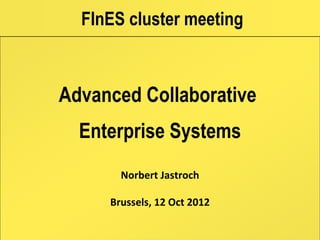
5 5-norbert jastroch
- 1. FInES cluster meeting Advanced Collaborative Enterprise Systems Norbert Jastroch Brussels, 12 Oct 2012
- 2. The Multi‐Dimensional Unified Process provides an advanced model of engineering for complex enterprise systems, products and projects, in an interorganizational collaborative environment aiming to strengthen the European software industry with the know‐how to build complex services and big data management in a multi‐layered cloud computing continuum.
- 3. Research Group International group of researchers working on Inter‐Organizational Collaborative Software Engineering • Norbert Jastroch – MET Communications GmbH • Vassilka Kirova – Alcatel‐Lucent • Cyril S. Ku – William Paterson University • Thomas J. Marlowe – Seton Hall University • Mojgan Mohtashami – Advanced Infrastructure Design • Susu Nousala – Aalto University
- 4. Collaborative Enterprise Systems Collaboration of different organizations requires integration of processes interoperation of systems transfer of information/data across organizational boundaries
- 5. Collaborative Software Engineering • Software development is collaborative in nature, especially for large, complex, and innovative systems • Collaboration shifts from intra‐organizational to become more inter‐organizational, inter‐cultural, and international • Economic factors (gain competitive edge in less expensive labor markets and expertise by out‐sourcing and/or off‐shoring, sub‐contracting, academic‐industrial collaboration) • Advanced technology in computing environment, interfaces, internet, network communication, wireless – Examples: Cloud, IoT, IoS • Scope of collaboration • All activities related to the definition, production, acquisition, integration and evolution / maintenance of software systems
- 6. Software Engineering Models • Abstraction of the development process, specifying what the process involves in terms of activities and artifacts • 1‐dimensional models: e.g., Waterfall Model, Rapid‐Prototyping Model • 2‐dimensional (iterative and incremental) models: e.g., Spiral Model, Agile Process, Synchronize and Stabilize Model • Unified Process (a 2‐dimensional model) is well‐established for object‐oriented software design and development • More recently agile, light weight 2‐dimensional models and frameworks are being used more broadly • We propose a light multi‐dimensional model based on Unified Process or Agile Unified Process to accommodate inter‐ organizational collaboration and cost‐savings concerns
- 7. 1-Dimensional Model (The Waterfall Model) Requirements Project Management Specifications and Analysis Documentation Verification Design Implementation and Testing Delivery and Installation Post-Delivery Maintenance
- 8. 2-Dimensional Model Disciplines Increment Increment Increment Increment 1 2 3 4 Requirements Specification & Analysis Person-Days Design Implementation & Testing Maintenance Time
- 9. The Unified Process D iscip lin es In cep tio n E laboratio n C o n s tructio n T ran sition P h ase P h ase P h ase P h ase R eq u irem ents S p ecificatio n & An alysis Person-Days D esign Im plem entation & T estin g M aintenan ce T im e
- 10. The Multi-dimensional Unified Process • Technical and Business Dimensions Unchanged but enhanced to accommodate collaboration (e.g., partnership in a collaborative venture needs to be stabilized in the early phase of inception)
- 11. The Multi-dimensional Unified Process • Collaborative Dimension Partner responsibilities, policies and practices Partner capabilities and resources Software development process Knowledge management and risk management Quality assessment and consistency
- 12. The Multi-dimensional Unified Process • Management Dimension Legal issues, security, and intellectual property concerns, management objectives, systems objectives constrain the willingness and ability of the collaborators while trust and familiarity, formal and informal communication frameworks, and mediation processes affect the readiness for and the success of a collaboration
- 13. The Multi-dimensional Unified Process • Inter‐Dimensional Relationships Multiple dependences between/among artifacts and activities in the dimensions initial partition of responsibilities related to inception in Business Dimension modeling and requirements in Technical Dimension knowledge and risk management in Collaboration Dimension security and intellectual property in Management Dimension
- 14. Advancing Collaborative Enterprise Systems • Develop or select methods to support flexibility, specialization and evolution in and between all dimensions of the unified process • Manage collective ownership of knowledge and artifacts • Provide mechanisms and metrics to measure quality of collaboration and identify obstacles
- 15. Conclusion and Future Work • Modeling of multi‐dimensional relationships • Collaborative metrics are needed that may affect product, project, and process • Real world example to map Multi‐dimensional Unified Process to reality
- 16. Prior Work • Jastroch, N., Kirova, V., Ku, C. S., Marlowe, T. J., and Mohtashami, M.: “Adapting Business and Technical Processes for Collaborative Software Development”. Proceedings of the 17th International Conference on Concurrent Enterprising, ICE 2011, Aachen, Germany. June 20‐22, 2011 http://ieeexplore.ieee.org/xpl/freeabs_all.jsp?arnumber=6041218 • N. Callaos, T.J. Marlowe, N. Jastroch, S. Nousala, V. Kirova (Eds.): Collaborative Enterprises. Special issue of the Journal of Systemics, Cybernetics and Informatics, JSCI, Vol. 9/5. December 2011 http://www.iiisci.org/Journal/SCI/Contents.asp?var=&previous=ISS1105 • T.J. Marlowe, N. Jastroch, S. Nousala, V. Kirova: „Complex Collaboration, Knowledge Sharing and Interoperability“. Proceedings of the 18th International Conference on Concurrent Enterprising, ICE 2012, Munich, Germany. June 2012 http://ieeexplore.ieee.org/xpl/freeabs_all.jsp?arnumber=6297696 Further papers also available on ResearchGate , and SSRN
